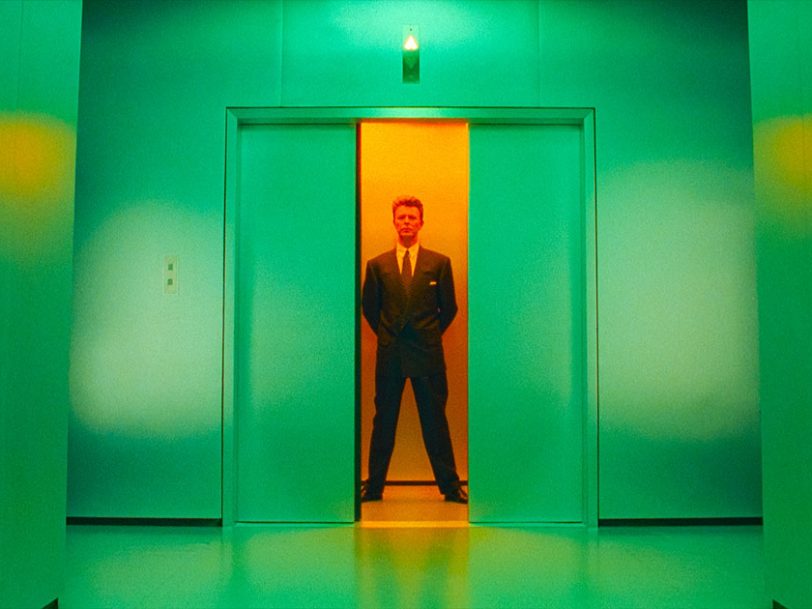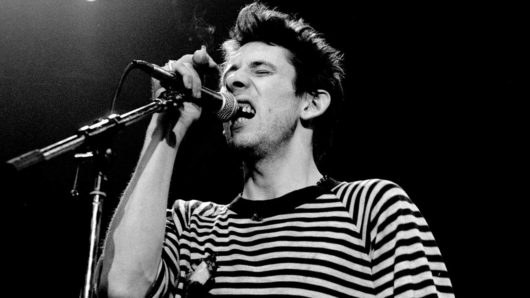Edited together from hundreds of hours of video footage and audio recordings, Brett Morgen’s Moonage Daydream documentary is a fittingly complex tribute to David Bowie. As compelling as its subject, the film explores Bowie’s own relationship with his art while also offering insight into how he evolved as a person, becoming one of the most important figures of the late 20th century in the process. One viewing is not enough to take it all in, but here are ten things that we learned from our first watch of the Moonage Daydream documentary.
1: Some people really did think he was an alien…
As a camera tracks Ziggy Stardust-era Bowie to the stage, a TV host is heard reeling off a list of questions that have begun to swirl around him: “Who is he? What is he? Where did he come from? Is he a creature of a foreign power? Is he a creep? Is he dangerous? Is he smart? Dumb? Nice to his parents? Real? Put-on? Crazy? Sane? Man? Woman? Robot? What is this?” Evidently, some fans found it equally difficult to separate the person from the persona, fuelling Bowie’s own psychological clash with his extraterrestrial creation. “I’m just the space cadet, he’s the commander,” says one Bowie acolyte. Bowie’s different-coloured eyes certainly helped set him apart from his earthbound contemporaries, and Bowie himself comments on the Ziggy phenomenon: “What it seemed to be was an alien rock star, and for performance value I dressed him and acted him out – I left it at that. Other people re-read him and contributed more information about Ziggy than I put into him.”
2: … But he was born in Brixton, in South London
Scrabbling to get to the bottom of things, a reporter asks Bowie what his childhood was like. Though one thread of the Moonage Daydream documentary explores Bowie’s uneasy relationship with his parents, he also makes clear that growing up as a boy named David Jones was a “regular” experience: “I went to school. I ate,” he says, though he also admits, “It feels to me that I don’t come from anywhere, but I was born in London.” Indeed, years before penning his first hit single, Space Oddity, Bowie spent part of his adolescence in London’s mod scene, an experience memorialised in his song The London Boys.
3: His half-brother, Terry, was one of the biggest influences on his life
A particularly poignant part of the Moonage Daydream documentary examines Bowie’s relationship with his older half-brother, Terry Burns. Turning the young David Jones on to Jack Kerouac’s classic Beat Generation novel On The Road, and introducing him to records by the pathfinding jazz saxophonist John Coltrane, Terry “gave me the greatest serviceable education I could ever have”, Bowie observes. Inspiring the Hunky Dory album song The Bewlay Brothers, Terry was effectively the reason Bowie decided to follow his own creative instincts: “He introduced me to the outside things… that just weren’t the currency when I grew up.”
4: Bowie understood the importance of mental health
After completing National Service in the RAF, Terry’s mental health took a severe decline, and, following long-term hospitalisation, he would tragically take his own life. Sensitive to his brother’s struggles, Bowie would examine his own psychological wellbeing. “I think it made me worry about my own disposition,” he says of Terry’s experience, admitting that he began to wonder whether he had “eccentric ideas, or whether I was headed somewhere else”. Eventually, Bowie concludes, “I developed a system against it, and that became a form of art.” From songs such as All The Madmen, from The Man Who Sold The World, to some of the key inspirations behind his 1995 album, 1. Outside, mental-health issues often informed Bowie’s music.
5: He wasn’t afraid of taking risks – even if they threatened his own safety
“I have to keep examining my life to make sure I’m in constant change,” Bowie says, describing creative about-turns as “challenges to myself”. In footage taken from the Cracked Actor documentary, filmed in 1974, Bowie explains his move to the US as a deliberate attempt to place himself in a situation where he didn’t feel comfortable. He would settle in Los Angeles the following year, in order to “see what would happen to my writing”. He emerged with the landmark Station To Station album, but the Moonage Daydream documentary also captures the sense of the death-defying lifestyle he lived at the time. Footage of LA’s seedier districts is intercut with a particularly unhinged live performance of Cracked Actor; by the time Bowie gives a Yorick-style skull full tongue, the point is clear: this was a man whose commitment to his art was in danger of tipping over into life-threatening extremes.
5: He wasn’t afraid of taking risks – even if they threatened his own safety
“I have to keep examining my life to make sure I’m in constant change,” Bowie says, describing creative about-turns as “challenges to myself”. In footage taken from the Cracked Actor documentary, filmed in 1974, Bowie explains his move to the US as a deliberate attempt to place himself in a situation where he didn’t feel comfortable. He would settle in Los Angeles the following year, in order to “see what would happen to my writing”. He emerged with the landmark Station To Station album, but the Moonage Daydream documentary also captures the sense of the death-defying lifestyle he lived at the time. Footage of LA’s seedier districts is intercut with a particularly unhinged live performance of Cracked Actor; by the time Bowie gives a Yorick-style skull full tongue, the point is clear: this was a man whose commitment to his art was in danger of tipping over into life-threatening extremes.
6: He sought to “invent a new musical language” in Berlin
Relocating to West Berlin in 1976, Bowie sought refuge from the harmful lifestyle he’d taken up in LA, and began to live at an altogether different pace – though he still continued to embrace uncertainty in his music. “Chaos and fragmentation is something I’ve always been comfortable with… That’s been my throughline,” he reflects, and it was a commitment to rethinking everything he knew about music-making that led him to the game-changing Low and “Heroes”[] albums. Built during improvisatory – and often uniquely challenging – recording sessions with his band and co-conspirators Brian Eno and Tony Visconti, the records were the result of Bowie’s determination to “invent a new musical language”. He more or less invented the entire future of rock music in the process.
7: Professionally filmed footage from his 1978 Earls Court performances exists
Known to have been professionally filmed, but never seeing the light of day (audio was used for the 2018 Record Store Day release Welcome To The Blackout (Live London ’78)), clips of Bowie’s performances at London’s Earls Court, as part of the Isolar II – The 1978 World Tour, receive their first public airing in the Moonage Daydream documentary. A holy grail for fans, Bowie is seen running through a soundcheck of the atmospheric near-instrumental Warszawa and a concert performance of the iconic song “Heroes”, showing just how much the band had developed since recording the live album Stage at the start of the tour. Other previously unseen live footage in the film includes Jeff Beck’s guest spot with The Spiders From Mars, during the final Ziggy show, at London’s Hammersmith Odeon, on 3 July 1973, and live footage from the 1974 Soul Tour of North America.
8: His artistic inclinations went far beyond music
Bowie’s interest in the visual arts is well documented: he amassed a private collection of art which made over $40 million at auction following his death, in 2016. “I sculpt, I paint, I write films… I make video television things that I do. Experimental video,” he tells one interviewer, expressing the wide range of interests his creative impulses spanned. Yet while one television host suggests that Bowie had used himself as a canvas, Bowie often shied away from exhibiting his own paintings, feeling that they were too personal. While other artists’ work, such as Erich Heckel and Gilbert & George, had inspired some of the best David Bowie album covers, it wasn’t until 1995 that Bowie used one of his own paintings – a self-portrait variously titled The Dhead Outside and Head Of DB – as an album cover, for 1. Outside. Some footage used in the Moonage Daydream documentary captures him at work on a large canvas during that era, and there is also a montage of portraits painted throughout his career, revealing that Bowie had a notable range as a painter.
9: He was the first rock star to appear in a Broadway show
Unsurprisingly for an artist who created so many iconic characters through whom he channelled his music, Bowie was also drawn to acting. One reporter notes that he had become the “only rock performer to act in a play on Broadway” when, in 1980, he took on the role of John Merrick in a stage adaptation of The Elephant Man. Footage from the run makes for a particularly captivating part of the Moonage Daydream documentary, proving that Bowie truly earned the critics’ plaudits, including praise from the New York Post, which celebrated “the most brilliant Broadway debut in recent memory”.
10: He learned to let love into his life
Working at an almost inhuman pace throughout the 70s, Bowie shut himself off from intimacy, choosing instead to commit himself to his art. “Love can’t get in my way because I shelter myself,” he says. Bowie would later admit to feeling a “distaste” for such comments, particularly in the wake of meeting Iman, whom he would marry in 1992. “Then I met Iman, and it was smack, that was it, it was over. Then my life became rose-tinted,” he says. Re-evaluating his life in his mid-40s, Bowie prioritised having a meaningful relationship over everything else; more than anything, the Moonage Daydream documentary celebrates Bowie’s quest for inner peace. “I’m dying. You’re dying. Second by second, all is transient. Does it matter? Do I bother?” he wonders, sounding victorious as he concludes: “Yes, I do. Life is fantastic.”
Buy David Bowie vinyl, box sets and more, at the Dig! store.
More Like This
Fleetwood Mac’s Buckingham-Nicks Years: The Albums, The Best Songs, 1975-1987
The albums recorded during Fleetwood Mac’s Buckingham-Nicks years, 1975-1987, turned the group into one of the most successful of all time.
Best Irish Musicians: 20 Shining Talents From The Emerald Isle
Famous for making music enriched with soul and passion, the best Irish musicians are revered the world over.
Be the first to know
Stay up-to-date with the latest music news, new releases, special offers and other discounts!




